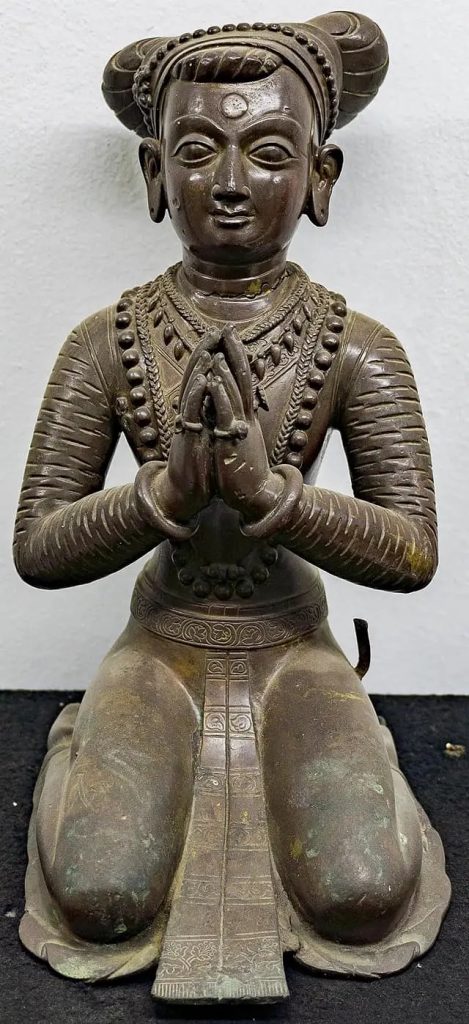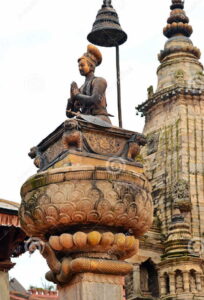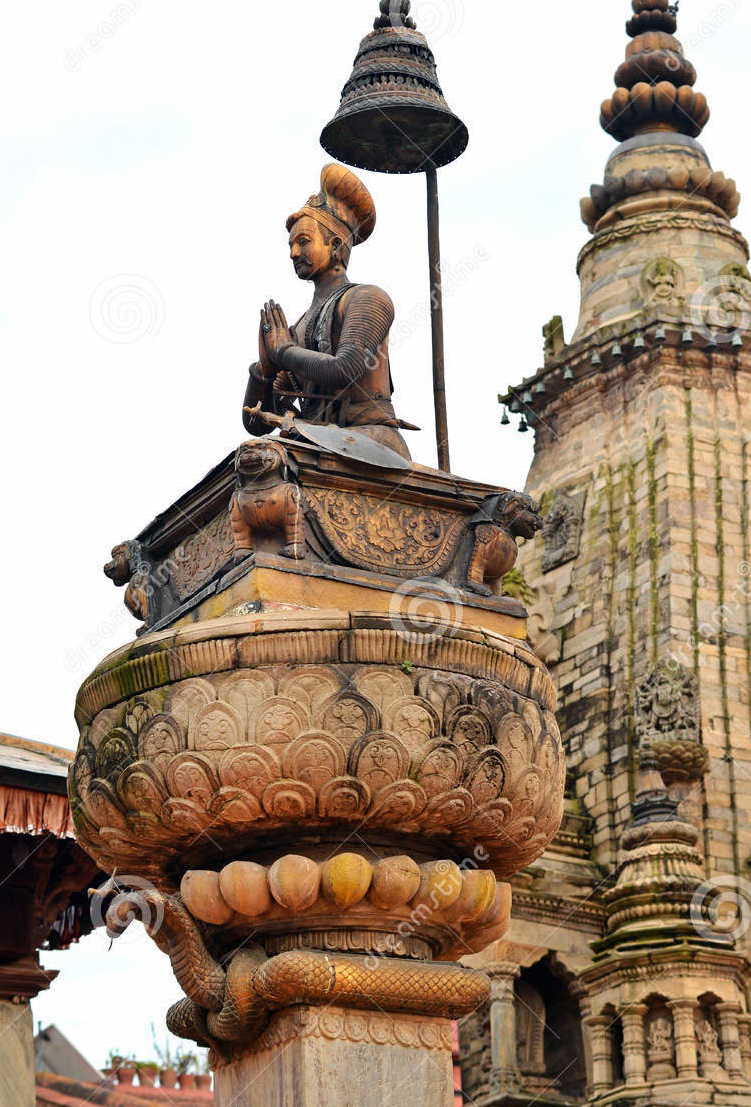Download Family tree (Best view in PC or Laptop) (GED file) FB>>
राजा रणजित मल्ल (King Ranajit Malla)
सन १७०३ मा राजा भूपतिन्द्र मल्ल र रानी विश्व लक्ष्मीका पहिलो सन्तानको रुपमा राजा रणजित मल्लको जन्म भएको थियो । सन १७२२ मा बुबाको स्वर्गारोहण पश्चात् राजगद्दीमा बिराजमान हुनु भएको थियो । भक्तपुरको बिकासमा उलेख्य भुमिका रहेका राजा रणजित मल्लको बिबाह राजकुमारी वृद्धिलक्ष्मी मल्लसंग भएको थियो । रानी वृद्धिलक्ष्मीका तर्फबाट जेठा छोरामा देवेन्द्र मल्ल थिए भने ऋद्धिलक्ष्मीका तर्फबाट जेठा वीरनरसिंह मल्ल र कान्छी रानी जयलक्ष्मी (मनमैजु)को तर्फबाट सात छोराहरु (भाजुराजाहरू) मा जेठा मनोरथसिंह मल्ल, माइला धनसिंह, साइँला उपेन्द्रसिंह, काहिँला अच्युत (अजित) सिंह, ठाइँला, अवधूतसिंह, कान्छा लक्ष्मीनरसिंह र सानोकान्छा जयनारायणसिंह थिए । बुबा भूपतिन्द्र मल्लले सुरु गरिएको स्वर्णद्वारको कार्यलाई राजा रणजित मल्लले निरन्तरता दिएका थिए । सुनको कमिले निर्माण कार्यमा ढिलो भएको यस स्वर्णद्वार सन १७५४ मा मात्र सम्पन्न भएको थियो । यसै द्वारमा राखिएको स्वर्णपत्र अनुसार नेपाल मण्डल अन्तर्गत नाल्दुम पुर्व दुधकोशी पश्चिम दोलखा सम्म रणजित मल्लको शासन रहेको थियो । त्यस्तैगरी १७२० मा खिचाखो गांको जिर्णोद्वार र १७३७ मा तलेजु भवानीमा समर्पित तग्गो गां (big bell) बनाएका थिए । ९९ चोकहरु मध्य एक भैरव चोकको प्रवेशद्वारको दायाँ पति आफ्नो र बायाँ पति बुबाको शालिक बनाउन लगाएका थिए जुन हालसम्म पनि सुरक्षित अवस्थामा रहेको छ । उहाँको समयमा बिष्णु पौभा चित्रकलालाई विशेष महत्व दिएका थिए भने उहाँकै पालामा चांदीका सिक्काको प्रचलन समेत गरेको थिए । उनलाई नरम स्वभावको र दयालु हृदयको राजाको रूपमा वर्णन गरिएको छ । उपत्यकाका अरु राज्यमा पृथ्वीनारायण शाहले बस्ने अनुमती नपाएपछी भक्तपुरमा उहाँलाई बस्ने अनुमती मात्र होइन आफ्नो छोरा वीर नरसिंह मल्लसंग मीत सम्म लगाइ दिए । मीतको लागि प्राण समेत दिने संस्कार रहेका राजाले युद्धकलाका साथै हातहतियार बारे तालिम समेत दिएका थिए । उहाँले सन १७६१-१७६३ सम्म भक्तपुरका साथै पाटनका पनि राजाको रुपमा काम गरेका थिए । वीर नरसिंहको रहस्यमय तरिकाले बिष खुवाएर हत्या भएपछि भाजुराजाहरुले राजा रणजित मल्ललाई सत्ताको लागि दवाव दिन थाले । यसै बिच गोर्खालीहरुले किर्तिपुर, कान्तिपुर र पाटन जितेपछी राजा जयप्रकाश र तेजनरसिंह भक्तपुरको शरणमा पुगे । सन १७६९ बि.सं १८२६ मा पृथ्वीनारायणको पत्रको जवाफमा सम्पूर्ण जनता र राजाले शरणमा आएकाको रक्षा गर्छौं, फिर्ता बुझाउने छैनौँ भन्ने जवाफ दिएपछि गोर्खाली मीतछोराले मीतबाबुसँग युद्ध गर्नैपर्ने भयो । यस युद्धको नेतृत्व मल्ल राज्यहरूका तर्फबाट भाजुराजा अवधूतसिंह, राजा जयप्रकाश मल्ल र राजा तेजनरसिंहले गरेका थिए । यस युद्धमा पनि भाजुराजाहरूमध्ये अवधूतसिंह र अजितसिंहबाहेक सबै भित्री रूपमा गोर्खालीसँग मिलेका थिए । गोर्खालीले कब्जा गरेको उत्तरतर्फका नाल्दुम, दोलखा र दक्षिणको मकवानपुरबाट नाकाबन्दीमा परेका र कीर्तिपुरे जनताको नाक काटिएको देखेका त्रसित जनता पनि नेपालमण्डलहरूलाई बचाउन उठेनन् । फलस्वरूप तीन दिन चलेको भक्तपुरको युद्धमा हार खाई तीनैजना राजाहरूले पगडी झिकी देखाई विसं १८२६ मा आत्मसमर्पण गर्नुपर्यो । मात्र १५०० गोर्खालीले भक्तपुरको ५०१ घरमा आगो लगाएका थिए र यस आक्रमणमा २१०० जना नेवार मारिएका थिए । भक्तपुरको प्रख्यात अभिलेखालय, पुस्तक, दस्ताबेज समेत जलाइएको थियो । भक्तपुर जितिसकेपछी युवराज देवेन्द्रका छोरालाई दरवारबाट सुरुङ मार्ग भै भगाएको बेला सुरुङ्को मुख हरिशंकर मन्दिर (लापांद्य:) अगाडि पुगेको बेला हत्या गरिएको थियो जहाँ हाल सम्म पनि एक ढुङ्गाले छोपेर राखेको छ । त्यसपछि केही भाजुराजाहरू पृथ्वीनारायण शाहले पहिले वचन दिएझैँ भक्तपुरको राज्य हाम्रो हुने भो भनी राज्य माग्न जाँदा पृथ्वीनारायण शाहले उल्टो उनीहरूलाई काठमाडौंमा कैद गरे । आफ्नो बाबुलाई धोका दिने गद्दार तिमीहरूले मलाई के छोड्छौ? भनी उनीहरूको नाक काट्न लगाई सर्वस्व हरण गरेपछि पृथ्वीनारायण शाहलाई मार्न उहाँका छोरा अवधूत सिंह मल्लको योजनामा भक्तपुरको न्हू पुखु (रानी पोखरी) मा रहेको ह्वाङ ह्वाङ पाटीमा लुकेर बसेका सर्दार भवानी सिंहले जब पृथ्वीनारायण शाह माथी आक्रमण गरियो तब तरवार म्यानमा अड्किनाले अंगरक्षक हर्ष पन्थले भवानी सिंहलाई त्यहीँ मारिदिए । यसरी पहिलो भक्तपुर विद्रोह असफल भयो । त्यस्तै राजा रणजित मल्ल, रानी जयलक्ष्मी र छोरा अबधूत सिंहमल्ल समेतलाई काशी पठाएका थिए । काशी जानेक्रममा “राम हा अ जि गन वनेगु …..” भन्ने गीतको रचना समेत गरेका थिए । तसर्थ उहाँलाई नेपाल भाषाका संरक्षकको रुपमा पनि मानिन्छ । काशी जानेक्रममै उहीँ साल भारतको बरणसीमा उहाको स्वर्गारोहण भएको थियो ।
राजा भूपतिन्द्र मल्ल (King Bhupatindra Malla)
राजा यक्ष मल्लको शासनकाल पछि बिभाजित स्वतन्त्र राज्य भक्तपुरका तेजस्वी राजाहरु मध्य एक राजा भूपतिन्द्र मल्ल हुन । सन १६७४ मा राजा जितामित्र मल्ल र रानी लालमती देवीका पहिलो सन्तानको रुपमा राजा भूपतिन्द्र मल्लको जन्म भएको थियो । बाल्यकाल देखि होनहार युवराजले बुबाले बनाउदै गरेका मठ मन्दिर, दरवार, शासन ब्यवस्थालाई नजिकबाट नियालेका थिए । सानी आमाले युवराज भूपतिन्द्र मल्ललाई मार्न षड्यन्त्र गरि नालाको जंगलमा लगेपनि होसियार युवराज त्यहाँबाट उम्कन सफल भएका थिए । यसै घटना पश्चात् कान्छी रानीका प्रेमी भाजुकसको हत्या भएको थियो । १३ बर्षको उमेरमा राजकुमारी विश्व लक्ष्मीसंग सन १६८७ मा उहाँको विवाह भएको थियो । राजकाजमा निकै सक्रिय रहेका युवराज सन १६९६ मा बुबा हुन्जेल नै भक्तपुरका राजा हुनु भएका थिए । यसै साल सर्वप्रथम सिद्धिलक्ष्मी वत्सला मन्दिर र सिंह ध्वाका दरवारको निर्माण गरेका थिए भने सन १६९८ मा नरसिंह बिसालको पनि निर्माण गरेका थिए । बुबाले निर्माण सुरु गरेको पचपन्न झ्याले दरवारको निर्माणको निरन्तरताबाट आफ्नो राजकाजको भार सम्हालेका थिए । सन १७०१ मा ५५ झ्याले दरवार पुर्णरुपले निर्माण गरेका थिए । आफ्नो जीवनकालमा सन १७०१ मा सुवर्णेश्वर मन्दिर, सन १७०२ मा न्यातपोल मन्दिर र च्वङा गणेशको निर्माण गरेका थिए । सन १७०३ मा छोरा रणजित मल्लको जन्म भयो र १७०७ मा झौर बहि (मंगलधर्मद्विप महाबिहार), र बसन्तपुर दरवारको जिर्णोद्वार गरेका थिए । सन १७१० मा बुबा जितामित्र मल्लको स्वर्गारोहण भयो भने सन १७१९ मा तीन तल्ले भैरव मन्दिर, सन १७२१ मा खिचाखो गां, सन १७२२ मा डोलेश्वरको तीन तल्ले मन्दिर लगायत अन्य मन्दिरहरु बनाउन लगाएका थिए । यसका साथै उहाँकै पालामा नेपालको बाटो भएर भारत तिब्बत व्यापार गर्ने ब्यापारीहरुबाट शुल्क उठाउने (कर) ब्यबस्था मिलाएका थिए । भक्तपुरका नेप जु:जु भनी चिनिने राजा भूपतिन्द्र मल्लले मलामी लान्दा बजाइने न्यखिं बाजाको आवाज सुन्ने बितिकै जनताको शोकमा आफुले खान्दै गरेको खाना पनि त्यगिदिन्थ्यो । हरेक दिन जसो मलामी लगिरहन्थ्यो भने हरेक दिन नै खाना त्याग्नाले बिमारी परेका राजालाई बचाउन काजीहरुले त्यसदिन देखि मलामी लग्दा बाजा बजाउन रोक लगाएका थिए । त्यसैगरि उहाँकै पालामा स्वर्णद्वार पनि बनाउन लगाएका थिए तर बिडम्बना सन १७२२ मा उहाँको देहावसान भएपछि यस कार्यले पुर्णता पाउन सकेन ।
PARENT (M) Bhupatindra Malla Birth 1696 Death 1722 Marriage to ? Father Jitamitra Malla Mother ? PARENT (U) ? Birth Death Father ? Mother ? CHILDREN M Ranajit Malla Birth 1722 Bhaktapur Death 1769 Marriage to ? PARENT (M) Ranajit Malla Birth 1722 Bhaktapur Death 1769 Marriage to ? Father Bhupatindra Malla Mother ? PARENT (U) ? Birth Death Father ? Mother ? CHILDREN M Bir Narsing Malla Birth Death Marriage to ?
Malla Dynasty
The Mallas ruled Nepal from 1200 A.D. to 1769 A.D. with few exceptions. The Reign of the Malla Kings is further divided into the Early Medieval Period and the Medieval Period. The Period after the Dark Ages is the Early Medieval Period. In this period, House Tripura and Jayastithi Malla dominated the politics of Nepal.
After 1482 A.D., Nepal was divided into three Kingdoms: the Kingdom of Patan and Kathmandu (They later separated after Siddhi Narsingh Malla), the Kingdom of Bhaktapur, and the Kingdom of Banepa(It dissolved into Bhaktapur). The Medieval Period and reign of the Malla Dynasty ended with the Unification of Prithvi Narayan Shah in 1769 A.D.
Rise and Arrival of the Malla Dynasty in Nepal
The Malla Kings ruled Nepal from 1200 A.D. to 1769 A.D., although they belonged to different families. The first Malla King, Ari Malla, began ruling Nepal around 1200 A.D. Historians hold varying opinions on the origin and arrival of the Mallas in Nepal and their eventual rule.
One group of historians believes that the Mallas originated from Ancient India, specifically Kushinagar. They later settled in the Plains of Terai and migrated along the Bagmati River before capturing the throne of Nepal.
On the other hand, some Nepali historians opine that the Mallas belong to the Ancient Feudal Region of Mallapuri, which revolted during the reign of King Manadeva of the Lichhavi Dynasty.
Initial historians of Nepal claim that “Malla” was limited to a title and meant nothing else. As “Malla” connotes a brave wrestler, it was an honorary title to be claimed, and the Khas Malla Kings possibly had some influence over such naming.
The first Malla King, Ari Malla, suddenly rose to power in 1200 A.D. The reason for his ascension to the throne is still unknown. Some argue that he held influence in the Court of Nepal and easily became the King when the chance arose. Others believe that the Mallas were originally feudal lords of Banepa who gradually accumulated power, leading to Ari Malla becoming the first Malla King of Nepal.
Important Kings of the Malla Dynasty
Jayastithi Malla
Jayastithi Malla is the most famous Malla King of Nepal and the patriarch of the Malla Dynasty in Nepal. He ruled Nepal from 1382 A.D. to 1395 A.D. During his reign, he implemented legal, judicial, social, cultural, and administrative reforms in Nepal. He arrived in Nepal from the fallen Tirhut Kingdom and married Rajalladevi.
By 1382 A.D., he had gradually removed Jayarjunadeva from power and claimed the title of King. Jayastithi Malla enforced the Varna Vyavastha among the Hindu and Newar communities of the Kathmandu Valley and implemented strict regulations.
He divided lands into four categories: Abal, Doyam, Sim, and Chahr. The king also encouraged artistic reforms, promoting music, paintings, dramas, etc. He declared Taleju Bhawani as the tutelary goddess of the Mallas.
Yaksha Malla
Yaksha Malla was one of the longest-reigning Kings of Nepal, ruling from 1428 A.D. to 1482 A.D. After his reign, Nepal was divided into four different kingdoms. He initiated various conquests and expanded Nepali territories but failed to consolidate the newly conquered lands.
He appointed priests in the Pashupatinath Temple and renovated the temples of Kathmandu, Bhaktapur, and Patan. Yaksha Malla was a patron of arts and literature in Nepal, and he is credited with building the Dattatreya Square and Dattatreya Temple. He passed away in 1482 A.D.
Mahendra Malla
Mahendra Malla was the King of Kathmandu from 1560 A.D. to 1574 A.D. He is renowned for his legal and economic reforms, contributing to the prosperity and stability of the Kathmandu Valley. He prioritized trade and other economic activities and built the Taleju Temple in Kathmandu.
Additionally, he introduced new silver coins known as “Mahendramalli” and established trade relations with India and Tibet. To address hunger and famine in Kathmandu, he enacted a set of laws during his rule.
Sivasimha Malla
Sivasimha Malla was the illegitimate King of Nepal from 1578 A.D. to 1617 A.D., ruling for a total of 39 years. He replaced his tyrannical step-brother, Sadasiva Malla, to become the King of Kathmandu. First, he successfully conquered Patan and removed the Simha Family from power.
Additionally, he renovated the Temple of Changunarayan in Bhaktapur and the Syambhunath Temple in Kathmandu. He expanded the lands of Kathmandu and gained some territories by defeating the Deva Dynasty of Dolakha. Ultimately, despite unifying Patan and Kathmandu, he divided them between Siddhi Narsingh Malla and Laxminarasimha.
Siddhi Narsingh Malla
Siddhi Narsingh Malla was one of the greatest Kings of Patan, ruling from 1618 A.D. to 1661 A.D., enjoying a long and prosperous reign of 43 years. He established diplomatic relations with Kathmandu, Gorkha, and Bhaktapur, earning him the title of the Peaceful King of Patan.
He was known for his religious temperament and built the famous Krishna Temple in 1636 A.D. Devoted to the Gods of Shaivism, Vaishnavism, and Buddhist Vajrayana Cult, he also built various other temples dedicated to the Malla Tutelary Goddess, Taleju Bhawani. Siddhi Narsingh Malla promoted dance, drama, and culture in Patan, encouraging arts and artisans within his realm.
He efficiently governed the administration of Patan by involving his son at a young age, and ultimately, he abdicated the throne in favor of his son, Srinivasa Malla.
Pratap Malla
Pratap Malla, the most famous King of Kathmandu, ruled from 1641 A.D. to 1674 A.D. He is renowned for constructing the famous Rani Pokhari Temple. During his reign, he had tense relations with his father, Laxminarasimha, and the mutual relations between Patan, Kathmandu, and Bhaktapur worsened significantly.
The passing of his son, Cakravartendra, led him to construct the Rani Pokhari to console his wife. Pratap Malla actively encouraged education, literature, poems, dramas, and other forms of arts within Nepal. He was even recognized as “Kaviraja” (King of Poets) due to his own poetic compositions.
Additionally, he was known for his proficiency in various branches of learning and his adeptness in the use of all kinds of weapons. He conquered some forts of Patan and forced other kings to accept his trade terms throughout the Kathmandu Valley. Pratap Malla brought religious reforms to Nepal, and despite being a tantric believer in the force of Tantric Yoga and its practices.
Jagat Prakash Malla
Jagat Prakash Malla was one of the well-known Kings of Bhaktapur, ruling from 1643 A.D. to 1672 A.D. He was a king who loved literature, earning titles like “King of Poets” and “Teacher and Master of Music.” He composed poems and literature regularly and had a great passion for dance, entertainment, arts, and architecture.
Jagat Prakash Malla also improved upon the Taleju Temple and built the image of Narayana. He was quite young when he ruled Bhaktapur and showed tremendous potential as a king.
He respected his ministers, including Visva Bharo, the first among them, as well as other chief ministers like Dhanadasimha Bhaju and Chandrasekhar Singh. Chandrasekhar Singh served as the de facto administrator of Bhaktapur for an extended period.
Srinivasa Malla
Srinivas Malla was the son of Siddhi Narsingh Malla and ruled Patan from 1661 A.D. to 1685 A.D. He was actively involved in the administration of Patan from a very young age. Srinivasa Malla expanded the borders of Patan near Tanahu and Gorkha.
After the death of Pratap Malla, he became the kingmaker of the Kathmandu Valley, maintaining political hegemony for a decade or so. He was also a king of strong religious temperament, donating lands to Machhindranath and erecting an image of Taleju Bhawami.
Srinivasa Malla enjoyed dance, drama, literature, and theater. His famous minister, Bhagirath Bhaiya, was considered his alter-ego. Ultimately, Srinivas Malla abdicated the throne of Patan due to his son’s adulterous activities with lower-caste women.
Jitamitra Malla
Jitamitra Malla was the King of Bhaktapur from 1672 A.D. to 1696 A.D. He became king at a very young age and was known for his charismatic personality. He had popular ministers like Bhagirama at that time. Despite the continuous battles among the Malla Kingdoms, he aimed to maintain peace and friendship between them.
Jitamitra Malla was instrumental in constructing several water channels and canals around Bhaktapur Palace and Thimi, and he established rules regarding their usage. He also promoted arts and architecture in Bhaktapur, improved the palace, installed various images, and repaired some ponds.
Additionally, he had a passion for literature, drama, and plays and is said to have written a commentary on the poem “Gita Govinda.” He voluntarily abdicated the throne and made Bhupatindra Malla the King of Bhaktapur.
Bhupatindra Malla
Bhupatindra Malla, the son of King Jitamitra Malla, ruled Bhaktapur from 1696 A.D. to 1722 A.D. He is the most famous King of Bhaktapur and rightfully so. During his reign, he built the famous Nyatpola Temple, Taleju Temple, and the Golden Gate in his palace.
Bhupatindra Malla was known for his passion for arts and architecture and used unique techniques in the construction of his temples. He conducted a treaty with the East India Company to regulate commerce between the Kathmandu Valley and the East India Company.
He also constructed the famous 55-Windowed Palace in Bhaktapur. Bhupatindra Malla prioritized poetry and drama, composing poems based on the Mahabharata. Often, he is referred to as the Pratap Malla of Bhaktapur. He passed away in 1722 A.D., after which his son Ranajita Malla became the King of Bhaktapur.
Important Political Events of the Malla Dynasty
Tripura Royal Family
The Tripura Royal Family, the feudal lords of Bhaktapur, wielded significant power in Kathmandu during the mid-13th and 14th centuries. In conjunction with House Bhonta, under King Jayabhimadeva, the Tripura Royal Family sequentially ruled Nepal.
Initially, Jayabhimadeva of House Bhonta ruled Nepal from 1258 A.D. to 1271 A.D. Then, Jayasimha Malla of House Tripura ruled for three years until 1274 A.D. Subsequently, a dummy king named Ananta Malla was placed on the throne, while real power was exercised by Jayatunga Malla.
Later, Jayatunga Malla’s son, Jayarudra Malla, became the de facto ruler of Nepal. Therefore, Jayasimha Malla, Jayatunga Malla, and Jayarudra Malla were the powers behind the throne of Nepal during the period when the country was transitioning from the Dark Ages. They played a crucial role in making Nepal more powerful and expansive.
Arrival of Jayastithi Malla
The arrival of Jayastithi Malla marked the most important event of the Early Medieval Period. He was brought from the Tirhut cum Terai Region and lacked clear ancestry. Nevertheless, he married Rajalladevi, the granddaughter of Jayarudra Malla, guided by Devaladevi, Jayarudra Malla’s sister and the last queen of the Tirhut Kingdom.
Jayastithi Malla was assumed to be a charismatic figure with ambitious nature. After marrying Rajalladevi, he slowly consolidated power in her name, and by 1382 A.D., he deposed Jayarjunadeva and ruled Nepal as its king from 1382 A.D. to 1395 A.D.
He established his sons as the future kings, and in fact, it was Jayastithi Malla’s dynasty that continued ruling Nepal until the conquest of Prithvi Narayan Shah.
Establishment of the Sons of Jayastithi Malla
Although Jayastithi Malla claimed the title of King of Nepal, he faced competition from Jagatsimha Vardhana, the feudal lord of Banepa and son of Anekarama Vardhana. Hence, the Malla Dynasty wasn’t yet firmly established as the ruler of Nepal.
Jayastithi Malla’s three sons (Jayadharma Malla, Jayajyotir Malla, and Jayakirti Malla) were kings in the same period. By 1408 A.D., Jayajyotir Malla remained the only Malla King of Nepal. His position was at risk due to revolts in Banepa.
However, Jayajyotir Malla managed to defeat all his competitors and establish superiority over Nepal. Although Jayajyotir Malla is rarely attributed to the establishment of the Malla Dynasty, his role was highly significant.
Division of Nepal
The division of Nepal into four distinct kingdoms after the death of Yaksha Malla was one of the most surprising events of the Early Medieval Period. It marked the transition of Nepal from the Early Medieval Period to the Medieval Period and the shift from a united kingdom to tens of kingdoms within Nepal.
Despite ruling United Nepal for nearly half a century, Yaksha Malla failed to unite his sons. The conflict between his two sons, Raya Malla, and Ratna Malla, was the most important cause for the division of Nepal. Raya Malla, the Crown Prince, was given the home kingdom of Bhaktapur.
Ratna Malla, the ambitious third eldest son, was given Kantipur and Lalitpur. Ultimately, Rana Malla, the second eldest son, received the Kingdom of Banepa.
Rise of the Simha Family
The Simha Family was one of the Seven Mahapatras of Patan. Led by Visnusimha, they managed to oust Narendra/Amara Malla from Patan and became its de facto rulers. Visnusimha ruled Patan from 1536 A.D. to 1556 A.D. His three sons succeeded him as rulers of Patan.
His son, Purandarasimha, outlasted his brothers and also proclaimed the title of King (Maharajadhiraja). However, by 1596 A.D., Purandarasimha was defeated by Sivasimha Malla. Nonetheless, the Simha Family became the first non-Malla kings to rule the kingdoms of the Kathmandu Valley after Jayastithi Malla.
Rise of Chief Ministers and Regent Queens
One of the most interesting aspects of Medieval Malla history is the dominance of Chief Ministers and Regent Queens in Nepalese politics. After the death of Jayarudra Malla, his daughter Nayakadevi retained the rights over Nepal.\ However, being young, she was guided by Jayarudra Malla’s mother, Padumalladevi, and his sister, Devaladevi. Even Nayakadevi’s daughter, Rajalladevi, was guided by Devaladevi.
The division of the Kathmandu Valley saw the rise of Queen Regents in Nepal, especially after 1700 A.D. First, the daughter of Pratap Malla, Riddhilakshmi, acted as the Regent during the reign of Bhupalendra Malla from 1687 A.D. to 1700 A.D. She was regarded as the main source of power in Kathmandu. Another Queen, Bhuvanalakshmi, acted as Regent in Kathmandu from 1700 A.D. to 1715 A.D.
Yogamati, the daughter of Yoganarendra Malla, gained unquestioned power after the death of Yoganarendra Malla. Perhaps, the greatest Regent Queen was Ganga Rani, the wife of Visva Malla and Regent to her son Trailokya Malla. She even proclaimed the title of ruler and was the real power behind the throne.
Other Regent Queens such as Rajyesvaridevi, Yogamati, Manimati, Bhagyavati, etc. also existed and dominated the politics of the Kathmandu Valley for a short time.
Among the Chief Ministers before the Medieval Period were the famous Vardhana Family with Anekarama Vardhana and Jagatsimha Vardhana consecutively. Then, other ministers such as Bhagirama, Laxminarayan Josi, Visva Bharo, Bhagirath Bhaiya, etc. dominated the politics of the Kathmandu Valley and influenced the decisions taken by the kings.
Malla Administration
The Malla Administration was dynamic and continuously evolving. It consisted of multiple administrative posts but lacked the tribunals present during the Lichhavi Dynasty. At the center of power was the King, holding the most powerful post as Nepal was an absolute monarchy. The King wielded absolute divine authority, and the position was generally hereditary, with the Malla family being the reigning kings at that time.
Following the King, there was the post of Regent, typically reserved for certain cases. The Chief Minister, also known as Mahath or Chautara, played a crucial role in conducting the administration of the nation. They were responsible for overseeing finance, war, security, and other vital matters.
Additionally, there were Mahasamantas and Mahapatras, who were hereditary aristocratic feudal lords possessing significant power, sometimes leading to clashes with the King.
Appointed officials known as Mulamis, the principal administrators of the state, followed the aristocratic lords. They assisted the Prime Minister and King in the administration of the state. Under the Chautara, there were Pramanas who represented the government and supervised district administration, and conducted Jatras, among other duties.
For local administration, Rabuttas governed the areas near the Pharping Region, while Mahamandaliks or Pramukhs ruled Mandals, district-like regions, under the guidance of Mahath and Mulami. Dwares also governed a division of the Kathmandu Valley.
For legal and judicial matters in Nepal, Kotling was the primary Court of Justice with jurisdiction over civil cases of the society, presided over by the Nyayakari. Criminal cases were handled by Itachapali, presided over by Brahmins, and based on the Dharmashastras.
The Dharmadhikaris were knowledgeable Brahmins of the time. Rajguru, the Royal Advisor of the King, also played a role in regulating the laws. The Malla Administration was structured around individual posts, as the geographical size of the kingdoms was smaller compared to the Lichhavi Dynasty.
Malla Society
Malla Society was dominated by traditional Hindu practices such as casteism, the Varnashram system, joint family structure, the development of the Newari language, and polygamy. The society was divided into four castes and thirty-six sub-castes, including Newar and other communities in the caste system. The ruling aristocratic class was the Kshatriyas, and during this period, the Newari language gained prominence over Sanskrit.
Families lived under the joint family system, and marriage often occurred at a young age. Polygamy was practiced, allowing a man to have more than one wife. Bell marriage and Sati were also prevalent customs during this period. Various festivals and customs, particularly Jatras, dominated the Kathmandu Valley.
Prominent Jatras included Krishna Jatra, Indra Jatra, and Ghode Jatra. While Hinduism became the primary religion of the Kathmandu Valley during the Malla period, Buddhism also coexisted.
The houses of the Malla Society were generally three to four stories with wooden windows and doors. Rice was the primary source of food, supplemented by wheat, barley, and duck. The Mughal Dynasty had a significant influence on the architecture and customs of the upper class. Malla Kings imitated Mughal Kings in their dressing style and ornaments.
Malla Economy
After the end of the Early Medieval Period, the Medieval Economy experienced significant growth and prosperity. Diverse industries, trade centers, small-scale businesses, and abundant cash crops contributed to Nepal’s economic advancement, especially after the 15th century.
The Kashmiri Muslims played a key role in the Tibet-Kathmandu-India trade, greatly benefiting Nepal’s economy. King Mahendra Malla of Kathmandu obtained permission from the Mughal Emperor to mint coins, and his coins became the official currency for transactions for centuries.
Nepal’s primary exports included silk, sheep, leather, and wood, generating substantial revenue from trade. Tibet, due to religious beliefs, did not mint its own coins, leading Nepal to export brass, copper utensils, clay idols, and various other goods.
The land itself was divided into Rajkshetra, Birta, Jagir, and Guthi, providing land revenue and religious assistance. The Malla Kings managed the land based on its productivity, generating significant revenues from agricultural products. Agriculture was a crucial source of livelihood for the people, while animal husbandry received less attention due to the scarcity of available land.
Another major source of government revenue during the Malla period was taxation. Three primary types of taxation practices were employed: cash, property, and services. Although cash was scarce, lands, houses, and forts were subject to cash taxes. Voluntary labor known as “Jhara” was also utilized by the state for social and economic enhancements.
Malla Foreign Relations
During the Malla period, foreign relations were greatly influenced by the Indian subcontinent. After the fall of the Kingdom of Tibet in the 10th century, Nepal developed closer ties with Indian kingdoms.
The Tirhut Kingdom, under King Harisimhadeva, was attacked by Gayasuddhin Tughlaq, leading the Tirhut Prince and Queen to seek refuge in Nepal and eventually bring Jayastithi Malla to power. Sultan Shamshuddin Ilyas also attacked Bhaktapur, resulting in the destruction and looting of substantial wealth from Nepal.
Trade and cultural exchanges were prominent aspects of Nepal’s foreign relations during the Malla period. Kashmiri Muslims were introduced to Nepal, engaging in trade with Tibet and the northern regions of Nepal. Nepalese products such as leather, musk, and other exotic goods received praise from Indian kings.
Nepali copper and swords had been renowned in the Indian subcontinent since ancient times. Nepal also minted coins under King Mahendra Malla of Kathmandu, making them the official currency for trade until after the unification of Nepal.
Religiously, many Christian missionaries were allowed to live within the Kathmandu Valley under the Malla Kingdom of Nepal. Among the most famous missionaries was Ippolito Desideri, who wrote extensively about Nepal. Numerous other missionaries arrived in Nepal to preach their religion and travel to Tibet and China.
Regarding Tibet and China, the most famous relationship was established through Nepali artist Araniko and eighty other artists. Araniko was famed and became a courtier in the Chinese court. Scholarly exchanges on Buddhism and Buddhist philosophy were frequent between Tibet and Nepal.
The trade route from Nepal to Tibet through Kerung-Kuti Pass served as the gateway to China. Various Christian missionaries, such as John Cabral, Grober, Desideri, and many others, traveled through Nepal on their journey to reach Tibet. Capuchin ministers also reached Nepal.
This period also witnessed wars between Tibet and Nepal. Yaksha Malla is said to have challenged Tibet’s authority up to Sikarjong, ultimately gaining control over Tibet. King Pratap Malla also engaged in a war against Tibet, emerging victorious and gaining the power to build trading houses in Tibet, further contributing to Kathmandu’s economic prosperity.
The foreign relations of the Malla Dynasty were characterized by trade, commerce, war, border tensions, mutual cultural exchange, and religion.
Conclusion
The Descendants of Jayastithi Malla ruled the Kathmandu Valley from 1395 A.D. to 1769 A.D. The Malla Period was shaped by these rulers that improved the Cultural, Economical, and Architectural Significance of the Kathmandu Valley.
The First Contacts with Western Civilization also flourished during the Reign of the Mallas. They were the most prominent Dynasty of Nepal after the Lichhavi and were replaced by another Prominent Dynasty, the Shah Dynasty.




